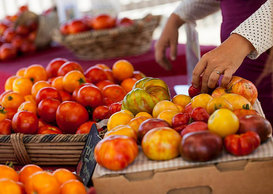Research Shows Farm to School Works
Schools started using local foods
in school meals, planting edible gardens, and teaching students about
where their food comes from in the early 1990’s. Today, these activities, in
addition to many others, are taking root all across the country. Farm to school
programs exist in every state. They stimulate local and regional economies,
improve children’s health and nutrition, and create widespread school and
community benefits.
This new fact sheet provides a
summary of findings from the 2015 Farm to School Census and recent research studies. According to the latest Farm to School Census,
42
percent of school districts participate in farm to school activities which
equates to more than 5,200 school districts, working with more than 42,000
schools, impacting more than 23.6 million children. During the 2013-2014 school
year, schools spent almost $790 million dollars on local foods!


 Spotlight on Summer
Summer’s
here! Are you serving local foods through USDA’s
Summer Meals Programs, taking a farm field trip while school is
out, serving meals at a school or community garden, farmers market, or offering
other farm to summer activities?
Tell us about it!
Send
us a photo or two and a description of how you bring local, nutritious foods to
kids and teens during the summer months, and we’ll feature the most creative
practices in our E-letter and/or on our blog to shine a national spotlight on
your programming. Interested in getting started? Check out our farm to summer website
for guidance, tips, and best practices.

 Grantee Spotlight
Dallas Independent School District
(DISD) is a former USDA Farm to School planning grantee (FY2013) and currently in year two of
an FY2015 implementation award. Their project has three focus areas:
- The
district encourages increased consumption of fruits and vegetables by expanding
and building upon their existing Harvest of the Month promotional activities,
taste tests, distribution of fresh produce at schools, and other activities
that promote the benefits of locally grown products;
- The district is
expanding experiential and agricultural based learning opportunities through
school gardens, field trips, and teacher trainings to integrate farm to school into
the curriculum and classrooms; and,
- They are working to expand their supply
chain by increasing the existing pool of local farmers who can produce items
for Dallas ISD.
DISD reflects on their recent efforts:
“Our greatest achievement came from the realization that
as of to date, we have doubled the amount of local produce we purchase since we
started tracking our local produce purchases in 2012. During the 2012-13
school year, Dallas ISD spent $320,000 on local produce (not including USDA Foods purchases). To date for the 2015-2016 school year (with April-June still to
go!), we have spent $630,000. We also anticipate featuring some locally grown items on
our summer food service program menu during the summer months.”
Congratulations, Dallas ISD, on all
of the great work!
|
Thanks for Connecting in Madison!
Thanks to the National Farm to School Network for organizing a fantastic Farm to Cafeteria Conference. We loved listening, chatting, and learning from everyone. From hearing Jessica Donze Black explain the intricacies of school lunch politics and exploring food justice with Ricardo Salvador to soaking up the energy behind advancing statewide networks and discovering all that Madison has to offer, we had an absolute blast! Thanks to everyone in attendance for elevating and advancing the conversation, while also bringing so many new faces to the table.
 Photos courtesy of the National Farm to School Network and Emma Cassidy

By Janna Raudenbush, Public Affairs Specialist, Food and Nutrition Service
Fields of asparagus and peas are in full bounty, soon to make way for
sweet, juicy strawberries; towering stalks of corn; and more tomatoes
than you’d ever know what to do with! In many parts of the country, as
we approach summer, the warm weather means that local harvests are at
their peak, and fresh fruits and vegetables abound. That’s what makes
summer the perfect time of year for incorporating local foods into your
meals. And according to the most recently released data from the Farm to School Census 2015, more than 1,000 school districts nationwide are doing just that: They’re bringing the farm to summer!
When school lets out for summer, there’s still a need to ensure the
millions of children who receive free and reduced-price school meals
during the school year have consistent access to healthy meals. USDA’s
summer meals programs help fill that gap, serving over 191 million meals
to children last summer alone! Community centers, libraries, day
camps, churches, and more can all sign up to host a summer meals site
through the summer meals programs, but schools make for a particularly
good site since they already have food production facilities in place
for serving meals throughout the school year. The Farm to School Census
2015 found that more than one in five school districts that participate
in farm to school programs report including local foods in meals served
through their summer meals programs.
|

|